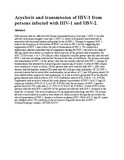Acyclovir and transmission of HIV-1 from persons infected with HIV-1 and HSV-2.

View/
Date
2010Author
Celum, C
Corey, L
Ridzon, R
Barnes, L
McElrath, MJ
Whittington, WL
Morrow, R
Coombs, RW
Thomas, KK
Campbell, MS
Stevens, W
Vwalika, B
Rees, H
Delany, S
Kanweka, W
Karita, E
Kayitenkore, K
Inambao, M
Allen, S
Coetzee, D
Kapiga, S
Manongi, R
McIntyre, JA
Gray, GE
G, de Bruyn
Fife, KH
Were, E
Essex, M
Makhema, J
Stewart, GJ
Farquhar, C
Kiarie, J
Ronald, A
Katabira, E
Cohen, CR
Bukusi, EA
Hughes, JP
Mullins, JI
Baeten, JM
Mujugira, A
Mugo, N
Wang, RS
Magaret, AS
Lingappa, JR
Wald, A
Type
ArticleLanguage
enMetadata
Show full item recordAbstract
Most persons who are infected with human immunodeficiency virus type 1 (HIV-1) are also infected with herpes simplex virus type 2 (HSV-2), which is frequently reactivated and is associated with increased plasma and genital levels of HIV-1. Therapy to suppress HSV-2 reduces the frequency of reactivation of HSV-2 as well as HIV-1 levels, suggesting that suppression of HSV-2 may reduce the risk of transmission of HIV-1.
We conducted a randomized, placebo-controlled trial of suppressive therapy for HSV-2 (acyclovir at a dose of 400 mg orally twice daily) in couples in which only one of the partners was seropositive for HIV-1 (CD4 count, > or = 250 cells per cubic millimeter) and that partner was also infected with HSV-2 and was not taking antiretroviral therapy at the time of enrollment. The primary end point was transmission of HIV-1 to the partner who was not initially infected with HIV-1; linkage of transmissions was assessed by means of genetic sequencing of viruses.
A total of 3408 couples were enrolled at 14 sites in Africa. Of the partners who were infected with HIV-1, 68% were women, and the baseline median CD4 count was 462 cells per cubic millimeter. Of 132 HIV-1 seroconversions that occurred after randomization (an incidence of 2.7 per 100 person-years), 84 were linked within couples by viral sequencing: 41 in the acyclovir group and 43 in the placebo group (hazard ratio with acyclovir, 0.92, 95% confidence interval [CI], 0.60 to 1.41; P=0.69). Suppression with acyclovir reduced the mean plasma concentration of HIV-1 by 0.25 log(10) copies per milliliter (95% CI, 0.22 to 0.29; P<0.001) and the occurrence of HSV-2-positive genital ulcers by 73% (risk ratio, 0.27; 95% CI, 0.20 to 0.36; P<0.001). A total of 92% of the partners infected with HIV-1 and 84% of the partners not infected with HIV-1 remained in the study for 24 months. The level of adherence to the dispensed study drug was 96%. No serious adverse events related to acyclovir were observed.
Daily acyclovir therapy did not reduce the risk of transmission of HIV-1, despite a reduction in plasma HIV-1 RNA of 0.25 log(10) copies per milliliter and a 73% reduction in the occurrence of genital ulcers due to HSV-2. (ClinicalTrials.gov number, NCT00194519.)
URI
http://erepository.uonbi.ac.ke:8080/xmlui/handle/123456789/32619http://www.ncbi.nlm.nih.gov/pubmed/20089951
http://www.ncbi.nlm.nih.gov/pmc/articles/PMC2838503/
Citation
N Engl J Med. 2010 Feb 4;362(5):427-39. doi: 10.1056/NEJMoa0904849. Epub 2010 Jan 20.Publisher
College of Health Sciences
Collections
- Faculty of Health Sciences (FHS) [10378]
